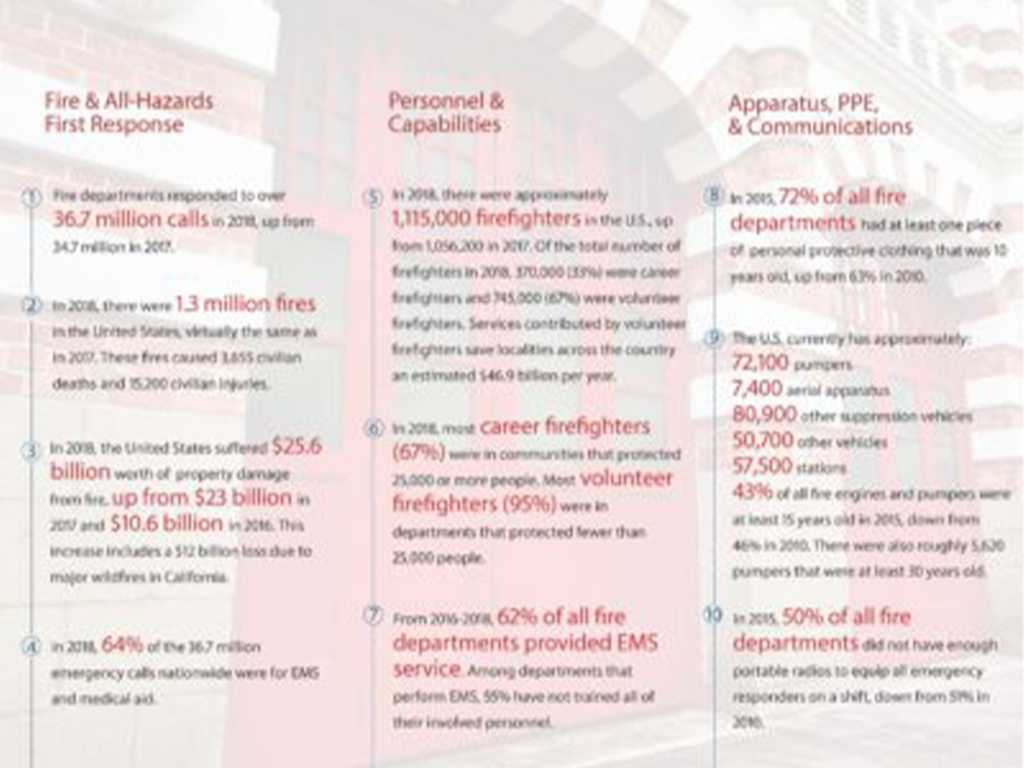10 Key Facts About the Fire Service & Industry
The American fire service, as first responders, serve as the first line of defense in the event of a fire, natural disaster, pandemic, terrorist attack, or other emergency. Here, FAMA and FEMSA members present 10 vital facts about the American fire service.
As America’s first responders combat the COVID-19 Pandemic, they not only face personal health risk, but their departments are also threatened by fiscal pressures, furloughs, and layoffs.
- Fire and EMS budgets now face an average cost increase of over 30% due to COVID-19.
- Fire and EMS teams are facing longer shifts by over 26%, on average, so that teams can plan and prepare for COVID-19-related calls and priorities.
- Through 2022, local government shortfalls are projected to be over $500 billion.
Fire & All-Hazards First Response
1. Fire departments responded to over 36.7 million calls in 2018, up from 34.7 million in 2017.
2. In 2018, there were 1.3 million fires in the United States, virtually the same as in 2017. These fires caused 3,655 civilian deaths and 15,200 civilian injuries.
3. In 2018, the United States suffered $25.6 billion worth of property damage from fire, up from $23 billion in 2017 and $10.6 billion in 2016. This increase includes a $12 billion loss due to major wildfires in California.
4. In 2018, 64% of the 36.7 million emergency calls nationwide were for EMS and medical aid.
Personnel & Capabilities
5. In 2018, there were approximately 1,115,000 firefighters in the U.S., up from 1,056,200 in 2017. Of the total number of firefighters in 2018, 370,000 (33%) were career firefighters and 745,000 (67%) were volunteer firefighters. Services contributed by volunteer firefighters save localities across the country an estimated $46.9 billion per year.
6. In 2018, most career firefighters (67%) were in communities that protected 25,000 or more people. Most volunteer firefighters (95%) were in departments that protected fewer than 25,000 people.
7. From 2016-2018, 62% of all fire departments provided EMS service. Among departments that perform EMS, 55% have not trained all of their involved personnel.
Apparatus, PPE, & Communications
8. In 2015, 72% of all fire departments had at least one piece of personal protective clothing that was 10 years old, up from 63% in 2010.
9. The U.S. currently has approximately: 72,100 pumpers, 7,400 aerial apparatus, 80,900 other suppression vehicles 50,700 other vehicles, 57,500 stations, 43% of all fire engines and pumpers were at least 15 years old in 2015, down from 46% in 2010. There were also roughly 5,620 pumpers that were at least 30 years old.
10. In 2015, 50% of all fire departments did not have enough portable radios to equip all emergency responders on a shift, down from 51% in 2010.








